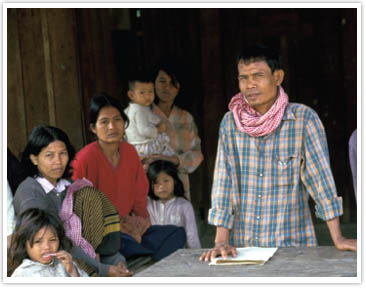Progress Report 2006
Basin Development Plan
The overall programme objective of the BDP was derived from the 1995 Mekong Agreement and supports the MRC vision of "an economically prosperous, socially just and environmentally sound Mekong River Basin", in line with the MRC mission "to promote and coordinate sustainable management and development of water and related resources for the countries' mutual benefit and the people's well being".
Using the principles of Integrated Water Resources Management the BDP aims to achieve a balance between socio-economic development and environmental concerns and to create a framework for development based on technical knowledge as well as public, stakeholder and political views. Through the formulation of development scenarios, the BDP is able to provide models for future water needs of the Lower Mekong Basin from which strategies and planning guidelines can be developed to assist the Member States plan their development in a sustainable way.

Over the past five years the BDP has developed a comprehensive IWRM Strategy which will provide a development intervention and investment plan for the Lower Mekong Basin to:
- Foster sustainable development
- Respond to the needs of the poor; and
- Ensure economic growth and development is in harmony with the environment.
The BDP covers all major types of water-related activities such as irrigation, watershed management, fisheries, hydropower, navigation, flood management and mitigation and domestic and industrial use.
BDP Phase 1 started in October 2001 as a three-year project. In 2003, it was decided to extend Phase 1 until the end of June 2005 and then to July 2006. A further no-cost extension provided a bridging arrangement up to the start up of the second phase, planned for January 2007. Financial support to the BDP Phase 1 formulation and the interim period is being provided by Denmark, Sweden, Japan, Switzerland and Australia.
In 2006 BDP Phase 1 achieved many final outputs:
- Establishment of an ongoing basin planning process
- Implementation of functional data systems
- Building of capacity and provision of training within MRCS, NMCs and national organisations resulting in well qualified staff and relevant institutional capacities available at MRCS and the NMCs
- Formulation of sub-area and basin-wide scenarios and strategies
- The setting up of a Projects Database (long-list) and prioritisation of water-related development projects
- An agreed shortlist of priority development initiatives, to be maintained by the JC as a continuous activity
- A functional network of more than 200 agencies actively collaborating on basinwide water-related development.
- An agreed "Strategic Directions for IWRM in the Lower Mekong Basin"
- Tools and routines for project identification, initial documentation, and screening of impacts and significance, classification and ranking (DSF, Resource Allocation Models, Social Impact Assessment and Strategic Environment Assessment, Screening toolkits)
- An underlying comprehensive knowledge base and documentation, readily available to users within and outside the BDP, MRCS and the NMCs (the Core Library and the BDP Planning Atlas)
- An agreed programme for BDP2, formulated with full country input. The project document for BDP phase 2 is also regarded as a main output of BDP Phase 1.
The BDP has established a planning network in the Lower Mekong Basin built on a range of BDP planning tools and features. National BDP Units have been established in each Member State under the National Mekong Committees. In the near future, the collaboration between the BDP team at the MRCS, the BDP units in NMCs and other MRC programmes will be strengthened.
Strong links will be maintained with regional initiatives of external agencies, such as the Asian Development Bank's Greater Mekong Subregion programme, UNESCAP, ASEAN and the South East Asian Technical Advisory Committee of Global Water Partnership. There will also be scope for coordination with the upstream riparian countries. Published out puts include the Strategic Directions for IWRM in the LMB, together with a portfolio of projects and programmes to support it (the MRC-BDP Projects Database). The BDP Phase 2 programme objective is to ensure that the water resources of the Mekong River Basin are managed and developed in an integrated, sustainable and equitable manner for the mutual benefit of all riparians. It will develop and maintain a rolling IWRM based Basin Development Plan produced in support of sustainable development in the Mekong River Basin. It will further develop and effectively utilise the knowledge base and assessment tools in the MRC and the NMCs and it will build capacity at MRC and NMC levels for IWRM planning and for facilitation/mediation in areas where trade-off management is required The BDP Phase 1 is funded by the Governments of Australia, Denmark, Japan and Sweden. BDP2 commenced on 6 December 2006 with the signing of a funding agreement between the MRC and the Government of Denmark. The MRC is now seeking to cover the difference between the Danish grant and the total budget.
Choose a newsletter: